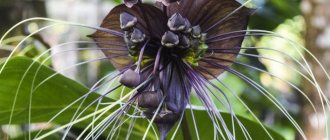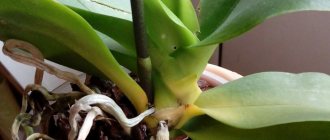The orchid is a real “queen of the garden” that can grow either at home or in the office. True, not all gardeners follow the rules for caring for these plants, as a result of which they begin to wither. For example, not every flower owner knows how to water an orchid after transplantation, and this is an important nuance.
Many people are accustomed to taking care of plants the “old-fashioned way”: fertilizing is done several times a year, replanting a couple of times, watering according to a schedule, and that’s where all care at home ends. This scheme is suitable for unpretentious flowers that can grow anywhere and anyhow, but orchids are a completely different matter.
How to understand when it's time to water an orchid
The substrates used for orchids are usually heterogeneous, and it is difficult to determine from their appearance whether the plant needs to be watered.
But there are other signs:
- Weight of the pot. If it has become too light, then most likely the flower has been thirsting for moisture for a long time. To make it easier to navigate by this sign, you need to pick up the pot after watering and feel its weight. After a few days, you need to check his weight again. If you feel significant weight loss, you should water.
- Check soil moisture with your finger. You need to push away the top layer of soil and dig into the remaining soil with your finger. If it is dry, then you need to water it.
- Insert a wooden stick. It is advisable to do this immediately after watering, and then simply pull it out periodically and see whether the wood at depth is dry or wet.
- Orchids are usually planted in transparent pots, so condensation is clearly visible on their walls. If it has disappeared, then it is necessary to carry out irrigation procedures.
- The roots are also visible through the transparent walls of the flowerpot. When their color changes from green to silver, as well as when a loss of elasticity is detected (they become wrinkled), they need to be watered.
- If the roots lose their elasticity, the leaves also become sluggish and droop.
- If there is a lack of moisture, a flowering plant will begin to drop flowers.
How many times and how often should the procedure be performed?
The irrigation schedule depends on a number of indicators:
- temperature;
- air humidity;
- lighting;
- dimensions of the flowerpot;
- seasonality.
In general, it is believed that in summer a flower should be watered 1–3 times every 7 days, and in the cold season, when the plant is dormant, 1–2 times a month.
It is recommended to carry out the procedures in the morning. Important! In the absence of irrigation for a long time, the flower should be restored by watering from the shower.
Lighting
During the first 7–10 days, the orchid should stand in a shaded place and under no circumstances be exposed to direct sunlight. The fact is that the absence of the sun imitates for this plant the native tropical (subtropical) rainy season, when the sky is covered with clouds, and the flowers “sleep” in a peculiar way, accumulating strength.
Then the orchid is returned to its usual place with diffused lighting and, if necessary, the lamp is turned on, bringing the daylight hours to 12 hours a day.
How to properly water an orchid after transplantation at home
It is not recommended to irrigate the orchid immediately after transplantation. It is advised to wait a week or two so that the plant can take root, of course, only if the reason for replanting is not the death of the roots after a long period of drought. Then you need to moisten the substrate a little. Irrigation activities can be carried out using one of the methods described below.
Dive
To implement this method, it is necessary to prepare a basin with water at a temperature of +20...+32°C. Before doing this, the container must be doused with boiling water. The pot is slowly immersed in water so that the water rises to the very top. It is held in this position for 1–2 minutes, then slowly rises and is left suspended for the same time so that excess water drains away.
For each flower, fresh water is collected, and the basin is doused with boiling water. This method is most often used when keeping the plant cool. It is quite effective and does not take much time.
Important! You can use immersion technology only if you are sure that the plant is not sick and the substrate is not affected.
Watering from above
Watering from above can be done using a watering can or spray bottle (spraying). You need to take a plastic watering can, since metal does not interact well with the roots of the flower. The pressure when watering should be weak, it is best to pour along the edge of the pot so as not to touch the sinuses and growing points. Water should be poured until it appears in the pan. Excess moisture is drained and the action is repeated after a few minutes. This method is ineffective because the soil is moistened unevenly.
Spraying with a spray bottle is also an ineffective method. It is more suitable for increasing air humidity. Warm water is used and the orchid is thoroughly sprayed with it for 20 seconds. Then take a short break and repeat the procedure again. In 30 minutes you need to do 3 irrigation procedures at equal intervals. After the shower, moisture is removed from the leaves and axils.
Running water
This type of watering will simulate rain. It is the most effective among all, since it saturates the flower with oxygen. Running water must be run through the shower. This will not only irrigate the plant, but also cleanse its foliage of parasites.
Did you know? Orchid flowers that are cut and placed in a vase stay fresh much longer than any other flower.
Flower pots should be placed in the bathroom and watered with low pressure of warm water (+40…+50°C) through the shower head. The water should completely moisten the substrate. After this, the plants are left for 20 minutes to drain off excess moisture. Then, after another 40 minutes, the leaves and shoots are wiped with a napkin.
Spraying the roots
This technique is used when a flower is grown without a substrate. When the root system dries, it is sprayed with warm water from a spray bottle until it again acquires a green tint. The next irrigation procedure is carried out when the roots lighten.
Further care
Next, the plant is cared for as usual, observing all the rules for watering the orchid and using various watering methods: with a shower, with a watering can and through the leaves by spraying.
- The usual watering regime for orchids for winter and autumn is once a week.
- For spring: once a week or twice every 10 days.
- For winter: once a week.
Attention! The frequency of watering an orchid at home is determined individually, based on the variety, indoor climate, specific substrate and time of year.
Read our experts' materials on how to water an orchid in a pot and what water and solutions to use.
Is it possible to water an orchid?
You can water indoor flowers not only with water, but also with additional means. They increase plant immunity and accelerate their growth. Among such agents are succinic acid and the drug “Kornevin”.
Succinic acid
The chemical name of the product is dicarboxylic acid. Acid crystals are extracted from amber. This remedy is effective when it is necessary to accelerate the growth of indoor flowers.
Recommended reading
How to care for orchid roots
In addition, it is useful for orchids in the following ways:
- stimulates the growth of the root system;
- increases the number of buds and increases the duration of flowering;
- promotes better absorption of nutrients from the soil;
- increases the likelihood of effective rooting of cuttings;
- strengthens the transplanted plant;
- restores a sick flower.
Unfortunately, the product acts slowly, and frequent use causes the soil to become acidic. However, it is harmless to plants and humans, so you can safely use it.
"Kornevin"
The active substance in the drug "Kornevin" is indolylbutyric acid. When it gets into the soil, the growth of the plant’s root system is stimulated. That is why this drug is very effective when it is necessary for a flower to take root faster.
In addition, it helps speed up flowering and prolong it. However, it is not advisable to use Kornevin too often. Use it when you need to quickly revive an orchid, for example, if it is dying due to rotting of the root system.
Using Kornevin
Is it possible to water it with Kornevin? Yes, and this is necessary to help the process of accelerated growth. The main substance that provides the effect of the drug is acid, the indolyl oil variety, it has a root-forming effect. Kornevin is used in two main ways . For powdering the roots before planting in a new substrate and for watering an already transplanted plant.
To saturate the roots of an orchid with a growth enhancer, you can also soak them before transplanting them into new soil in a solution - one gram of product per liter volume of water. For irrigation, make the same solution. Feed, focusing on the recommended hydration scheme corresponding to the specific circumstances of the transplant. When working with the drug, one should not forget about protective measures, since the product is dangerous to the health of people and animals. You must wear gloves and do not eat or drink during the procedure.
Signs of improper watering
If the orchid is not properly watered (over-watered), the following happens:
- the flower withers;
- the foliage is rapidly turning yellow;
- the roots rot;
- the core rots;
- partial wilting of foliage (deformation and color change);
- white “blisters” on foliage;
- the appearance of fungus on leaves, stems;
- Pseudobulbs rot.
Did you know? Succinic acid is the oldest chemical compound. It has been in living nature for more than 50 million years in the form of frozen tree resin.
Useful tips
When caring for an orchid, we advise you to adhere to the following recommendations:
- Carry out irrigation activities before lunch.
- Use running water or immersion methods.
- The water should not be hard.
- If you need to quickly soften the water, add oxalic acid to it.
- To speed up the adaptation of the transplanted flower, add minerals to the water (contained in special fertilizers for orchids).
After transplantation, any flower needs adaptation, and orchids are no exception. Particular attention should be paid to watering during this period. The further well-being of the flower and its vital activity will depend on its correct implementation.
Air humidity
After transplantation, it should imitate the conditions of the “jungle”. You can place regularly moistened moss or expanded clay around the orchid pot. Additionally, the orchid should be sprayed daily on all leaves and stems with warm, soft water. The abundance of moisture in the above-ground part activates the vitality of the plant and also promotes its rooting in a new place. Whether it is necessary to moisturize the orchid in this way for longer than 2 weeks from the day of transplantation depends on the specific species and variety.











